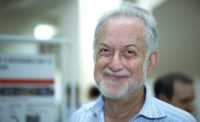Architects Remember Romaldo Giurgola

Romaldo Giurgola
Photo courtesy Mitchell|Giurgola Architects

Romaldo Giurgola
Photo courtesy Mitchell|Giurgola Architects

Parliament House, Canberra, Australia (1988)
Photo courtesy Mitchell|Giurgola Architects

Sherman Fairchild Center for the Life Sciences, Columbia University, New York City (1977)
Image courtesy Mitchell|Giurgola Architects

Sketch of Penn Mutual Tower, Philadelphia, Pennsylvania (1975)
Image courtesy Mitchell|Giurgola Architects





Architects & Firms
Romaldo “Aldo” Giurgola was born in Rome, Italy, and died this week in Canberra, Australia, the site of his most famous work: a government complex surrounded by bermed earth that made it possible for visitors to walk on and around the building. Giurgola moved to Canberra with his wife, Adelaide, who had Alzheimer’s Disease, in the 1980s, when the building, Parliament House, was under construction. He became an Australian citizen in 2000.
But even after an absence of 35 years, Giurgola is not forgotten in New York. Upon earning his B.Arch. from the the University of Rome, Giurgola moved to Manhattan in 1949, where he received his M. Arch in 1951 from Columbia University. In the early 1950s, Giurgola was an art director at Interiors magazine. Then in 1954, he began teaching architecture at the University of Pennsylvania, where he founded his firm with Ehrman Mitchell.
In those years Giurgola, along with Louis Kahn and Robert Venturi, became known as the “Philadelphia school,” because of the modernist vitality they brought to the city. His firm would continue to design a number of buildings in the Philadelphia area, but by 1966, Giurgola had returned to New York to teach at Columbia, where he was chair of the Department of Architecture from 1966 to 1971. In 1966 he also founded his New York office, which continues today.
Partners Steve Goldberg and Paul Broches said they had retained Giurgola’s name given, in Broches’s words, “the significance it continues to carry in the profession.” Indeed, in conversations with architects, “humane” and “kind” were used to describe both Giurgola's buildings, which used a modernist vocabulary in modest ways, and his personality. James Sanders, the author and architect, studied with Giurgola at Columbia in the late 1970s and early 1980s. “He was a lovely man, and a wonderful teacher and design critic—and for my generation, he felt like a direct link to an earlier, more heroic era in architecture, some of whose great figures—Kahn and others—had been his teachers and mentors.”
Judith Dupre was a rare New York architect who visited Giurgola in Australia. She remembers standing atop Parliament House, directly above “a square fountain that doesn't spray so much as it bubbles and murmurs like a great beating human heart.”
“Profound beyond telling was his understanding of the symbiosis between art and architecture. He pioneered the use of site specific art,” Dupre adds, citing several seminal examples in the U.S. and Australia.
Steven Semes, an architecture critic and avowed classicist, says, “He was one of the contemporary designers I most admired.” Duo Dickinson, the Connecticut architect and critic, recalls that in 1978, “after receiving my resume, he called me in for a meeting, then walked me through his office for an hour. After the tour, he said, ‘I would love to hire you, but I have just laid off 20 people.’ That kindness gave me great hope and encouragement.” Michael Manfredi and Marion Weiss, now partners in a successful New York firm, met while working for Giurgola in the 1980s. Says Manfredi, “His studio always felt like a place of learning as much as a place of work.”








